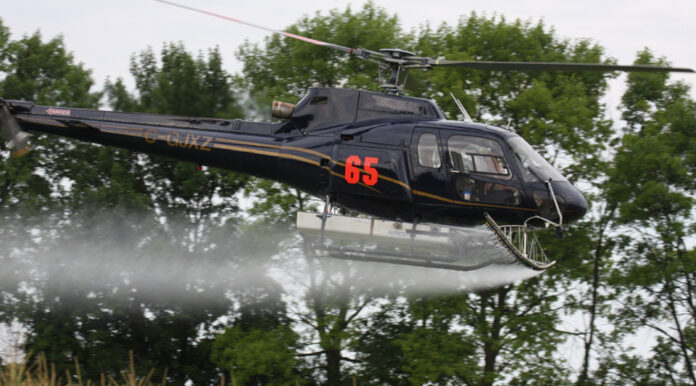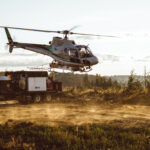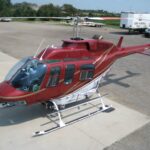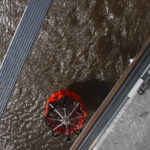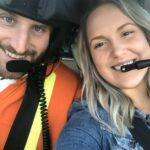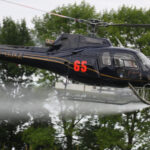Situated a short 60 miles away from the Motor City on the Canadian side of the Detroit River, Zimmer Air Services Inc (ZASI) has been in the aerial application business for over 40 years and currently runs a fleet of fixed and rotary wing aircraft. We caught up with Operations Manager Aaron Trudell, who also serves as President of the Canadian Aerial Application Association.
AAU: What got you interested in ag aviation in the first place?
AT: When I was 14, I was at my grandparent’s farm at a family picnic. We heard the very distinctive “thwop-thwop” sound of a helicopter coming in for a landing behind the barn. It had all been arranged by Paul Zimmer, ZASI President, and the pilot was giving people rides, me included. I was smitten by the flying bug then and there and started working for ZASI as a teenager during high school summer breaks. Over the years I obtained my CHPL, enrolled in an AME college program, and eventually started working for ZASI as a line pilot and then moved into management as Operations Manager.
AAU: What are your primary duties as Ops Manager?
AT: Being Ops Manager is a full-time job overseeing programs ranging from forestry seeding, larviciding, forestry pest management, and herbicide programs, along with the ag work we do. With a geographic area covering four provinces, there’s a lot to look after. In coordination with our Chief Pilot, and Director of Maintenance, recurrent training, and documentation upkeep for both aircraft and pilots are ongoing tasks, along with responding to RFPs and an unknown list of things that pop up constantly making for some long days at the office before, during and after the work season. Amidst that, I also have to ensure I maintain my currency on our aircraft.
AAU: How would you describe the state of the ag industry today?
AT: There is currently a high demand for crop and forestry protection provided by aerial applicators, but the overall usage is a reflection of Mother Nature. Some parts of the country have experienced drought conditions for the past two years, which can put a lot of operational and financial strain on operators.
In our local area, we’ve stressed to clients to utilize aerial application as a norm rather than as an ambulatory service used only in times of major disease outbreaks or abnormally high precipitation levels that make ground applications impossible. That approach for the most part has been successful both for the company, as well as the clients we serve.
We also have to remember that an important part of our industry is keeping in mind that the business relies on a healthy and sustainable environment and that means promoting practices that ensure aerial applications are done safely and effectively.
AAU: What is the role of the CAAA concerning regulatory agencies?
AT: The last couple of years we’ve seen inspectors conducting random audits throughout the industry and as far as we can see our industry is not only compliant with regulations, but we also take a proactive stance in working with regulatory agencies. We’re all after the same goal as the regulators, that of helping growers produce healthy, safe produce.
One of the things we have to recognize when working with regulators and governing bodies on issues from safety to the efficacy of products to potential adverse effects from pesticide applications is that the path to progress often requires a lot of flexibility when all parties are sitting around the table.
AAU: Is the CAAA working on changing label rates?
AT: Label rates are an issue in terms of water volume where some label rates are higher in Canada as compared to our US counterparts. Some registrants are working toward making changes and some are not and it has been a strong topic of discussion.
We had a small win at the end of 2023 with a change on a couple of labels but not as much as we would like, you take what you can get.
AAU: What is the current status of Dangerous Goods regulations related to aerial application?
AT: We are working with Transport Canada (TC) to update Dangerous Goods regulations to reflect the fact that aerial applicators do not carry dangerous goods. We’ve tried to adapt a DG policy for aerial applicators across the country but were informed by TC that this would not work, so currently each operator has to provide for DG training regardless of not carrying DG.
AAU: Have drones been a topic of discussion within the CAAA membership?
AT: We’ve had continuing discussions with TC regarding drone regulations, and we are currently waiting on responses from them from past meetings over the last 12 months regarding mandatory ADS-B installations at the point of manufacture, along with more stringent regulations. Notification was given in October last year from TC that a new Light Data Recorder (LDR) proposal was supposed to be released in late 2024.
When the initial Notice of Proposed Amendment notification (NPA) was released there was a unanimous pushback throughout the general aviation community. Following a review of the feedback, TC says they have come up with an alternate solution to the initial proposal. However, that has yet to be disclosed.
We have concerns with drones because 90% of our flying areas are in their realm which causes great concern regarding mid-air impact. After all, we know that some growers are using drones without compliance with label rates and proper certification for operation. Farmers are looking at this option because drones are so inexpensive, but the fact remains that there are very few products permissible in the eyes of the Pest Management Regulatory Agency (PMRA) for application by drones.
Drones may become more common for field scouting, research, application assessment/effectiveness, as well as yield assessment, but for application purposes it is undetermined. There have been many spray trials conducted over the last couple of years for research and data compiling. PMRA apparently will be releasing some labels in mid/late 2024 with ag products on them but product names are unknown at this time. Currently, to the best of our knowledge, the only product regarding an insecticide for drones are two larvicide products used to kill mosquito larvae in standing water.
AAU: Are there still ongoing discussions with Health Canada on the use of glyphosate?
AT: Glyphosate still is and most likely always will be under the microscope of its usage throughout the aerial application industry, not just ag. In the short term, I don’t see that changing as scientific research seems to swing back and forth on the findings leaving a lot open to individual interpretations.
AAU: Are there any new technologies on the market that can be adopted by aerial application operators?
AT: It seems every year we are seeing improvements in GPS technology from both accuracy and ease of use standpoints. It’s amazing how data can be downloaded for study and review on computers via cellular and Bluetooth technology. There are also continued improvements in auto booms and valves that make life easier and safer for ag pilots.
There has also been a lot of work carried out on ground rigs using spot spray-sensitive booms that allow growers to spray only the weeds present in a field using boom-mounted cameras and computerized processing to identify weeds as the sprayer moves across the crop. It’s also known as smart spray, precision spray, or targeted spray. However, I’m not sure if the technique will be viable for aerial applicators given the comparatively high speeds of aircraft compared to ground rigs.
All our aircraft are outfitted with Ag Nav Platinum units which have auto boom and auto flow technology to precisely handle the on/off spray and variable rates within an area. They, and similar units from other manufacturers, have been around for a while and are great in terms of maintaining rates during spray applications if and when airspeed varies. The ability of the auto system to precisely turn the booms on and off when entering and exiting spray areas and exclusion zones is quite impressive.
AAU: What are some of your priorities as CAAA President?
AT: A key role of the CAAA is to have open discussions with TC when they attempt to make changes to the 702 category when the changes don’t pertain to aerial application. We will continue to discuss with TC how any proposed changes will negatively affect aerial application operators and hopefully affect changes in the positive.
Another priority for me is to keep in touch with CAAA members and various committees within the CAAA, along with working with Transport Canada, the Pest Management Regulatory Agency (PMRA) and other national and provincial agencies.
Safety is another high-priority item. Because of the low-level environment we work in, safety cannot be stressed enough. Proper flight maneuvers and flying in a wire environment need to be practiced and safety measures taught constantly to ensure every flight is a safe return flight.
This year for the first time the CAAA is having a full-day workshop entitled “Flying in the Wire and Obstruction Environment”. It covers items such as how to identify signs of wires and why ag aviators hit wires they already knew were there. I’m sure this will prove to be a very helpful and informative training session for newcomers and experienced members of our industry alike.


